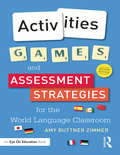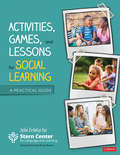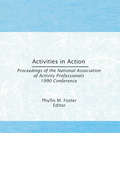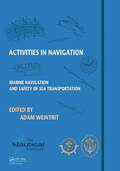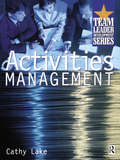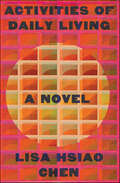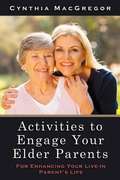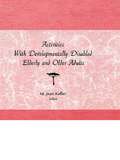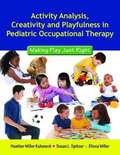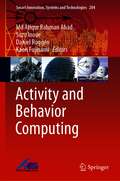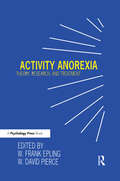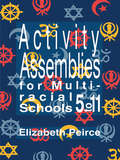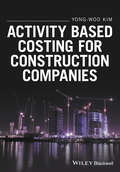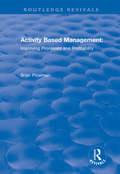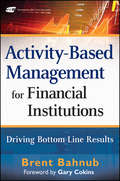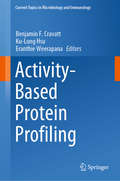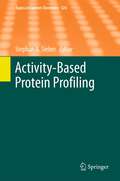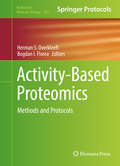- Table View
- List View
Activities, Games, and Assessment Strategies for the World Languages Classroom
by Amy Buttner ZimmerThis bestselling book is filled with fun activities you can use to engage students in learning a world language. No matter what language and grade level you teach, you will love having a wide variety of tools at your disposal, from quick warm-up exercises to longer games and group activities. Inside, you’ll find… Essential teacher tools and student organizational tools Strategies to promote and monitor class participation, including student self-assessments Strategies to promote and assess oral proficiency, such as prompts, quick chats, and role plays Warm-up activities and five-minute transitional activities Individual, pair, and group practice activities, with modification suggestions Games that make learning fun, with clear directions for how to do them Great websites and other resources to check out for more ideas The enhanced second edition features updated activities and technology suggestions throughout, as well as a tabbed design so it's easier to return to your favorite sections again and again. Bonus: The book comes with more than 30 templates—charts, rubrics, and game boards that can be photocopied from the book or downloaded as eResources from the book product page at www.routledge.com/books/details/9781138827295. You can modify and print them for classroom use.
Activities, Games, and Lessons for Social Learning: A Practical Guide
by Stern Center for Language and LearningIn these games, the prize is success in school—and life. Having good social skills doesn’t just affect classroom behavior—it’s the key to making learning stick. When students improve their self-regulation, social communication, and perspective-taking competencies, they are better prepared to challenge themselves academically, take on tough tasks, and collaborate with teachers and classmates to achieve real, lasting school success. And since these skills also improve life outside school, the benefits come full circle. Designed for both explicit instruction and "learning by doing," this practical guide provides hands-on activities that are easily adapted into any curriculum and can be used in general education, special education, after-school settings, and in the home. The design of each game keeps kids engaged and motivated, while educators benefit from clear, thorough explanations that unpack the complexities of social learning. Other behind-the-scenes features include: Evidence-based, teacher-tested lessons Anecdotes and real-world examples Links to relevant research Expansion ideas for applying learned skills to broader situations Templates and reproducibles for easy implementation This curated collection of activities puts social-learning theory into practice, helping even the most challenging children develop the social skills necessary for real success in school—and beyond.
Activities, Games, and Lessons for Social Learning: A Practical Guide
by Stern Center for Language and LearningIn these games, the prize is success in school—and life. Having good social skills doesn’t just affect classroom behavior—it’s the key to making learning stick. When students improve their self-regulation, social communication, and perspective-taking competencies, they are better prepared to challenge themselves academically, take on tough tasks, and collaborate with teachers and classmates to achieve real, lasting school success. And since these skills also improve life outside school, the benefits come full circle. Designed for both explicit instruction and "learning by doing," this practical guide provides hands-on activities that are easily adapted into any curriculum and can be used in general education, special education, after-school settings, and in the home. The design of each game keeps kids engaged and motivated, while educators benefit from clear, thorough explanations that unpack the complexities of social learning. Other behind-the-scenes features include: Evidence-based, teacher-tested lessons Anecdotes and real-world examples Links to relevant research Expansion ideas for applying learned skills to broader situations Templates and reproducibles for easy implementation This curated collection of activities puts social-learning theory into practice, helping even the most challenging children develop the social skills necessary for real success in school—and beyond.
Activities in Action: Proceedings of the National Association of Activity Professionals 1990 Conference
by Phyllis M. FosterHere is an invaluable resource for activities professionals specializing in geriatrics. Activities in Action reflects the goals of the National Association of Activity Professionals in that it serves as a catalyst for professional and personal growth and provides a national forum on geriatric and activity issues. Some of the highlights of this significant volume include a historical perspective of the activities profession, its growth and current contributions to the life and care of nursing home residents, and an overview of a national organization representing activities professional and how this organization has contributed to the growth of the profession. An extensive aging and leisure bibliography of timely publications related to activities and aging is also included.Specific chapters emphasize a variety of topics such as the impact of federally mandated nursing home resident assessment for activity professionals; the growing concern for the quality of life and its definition for nursing home inhabitants; the role of activity professionals in providing for the spiritual needs of the elderly whom they serve; how to deal with relocation stress and territoriality in nursing home occupants; and practical guidelines on how to employ and supervise activity assistants and work effectively with other staff as well as an activity coordinator. Activities directors, coordinators, assistants, and supervisors from all levels of experience will benefit from the insightful information in this innovative book.
Activities in Navigation: Marine Navigation and Safety of Sea Transportation
by Adam WeintritThe monograph Marine Navigation and Safety of Sea Transportation, Information, Communication and Environment, is addressed to scientists and professionals in order to share their experience, expert knowledge and research results, concerning all aspects of navigation and sea transportation.The focus of monograph is high-quality, scholarly research that addresses development, application and implications, in the field of maritime education, maritime safety management, maritime policy sciences, maritime industries, marine environment and energy technology. Subjects of papers include electronics, astronomy, mathematics, cartography, command and control, psychology, operational research, risk analysis, theoretical physics, operation in hostile environments, instrumentation, ergonomics, financial planning and law. Also of interest are logistics, transport and mobility. The monograph provides a forum for transportation researchers, engineers, navigators, ergonomists, and policy-makers with an interest in maritime researches.From contemporary issues to the scientific, technological, political, economic, cultural and social aspects of maritime shipping, transportation and navigation, the monograph publishes innovative, interdisciplinary and multidisciplinary research on marine navigation subjects and is set to become the leading international scholarly journal specialising in debate and discussion on maritime subjects. The monograph is especially concerned to set maritime studies in a broad international and comparative context.
Activities Management (Team Leader Development Ser.)
by Cathy LakeActivities Management is a comprehensive guide to running a smooth and successful operation. It includes:* practical help on how to plan and manage work;* health and safety in the workplace;* environmental considerations that today's supervisor needs to know. The Team Leader Development Series is an essential tool towards gaining the Supervisory Management Award. Consisting of four practical and interactive textbooks, this series will be invaluable not only to students, but also as a guide individuals and organisations seeking to improve their business performance at the first level of management.Key learning features:* Learning Objectives to enable the reader to assess the knowledge gained throughout the series.* Activities to put the learning into practice.* Case studies - 'true-life' scenarios!* Workbased Assignments which will also provide evidence for S/NVQ portfolios.* Language is straightforward and direct, contextualised to relate to team leaders and supervisory managers working in a wide range of industry sectors.* Influential protagonists in the field will be alluded to as appropriate to support the learning.Tutor resource material for each title in the series is available either as hard copy or is downloadable from the BH website. Please contact BH marketing on bhmarketing@repp.co.uk.
Activities of Daily Living: A Novel
by Lisa Hsiao ChenFinalist for the 2023 PEN/Hemingway Award for Debut Novel Finalist for the 2023 Gotham Book Prize Longlisted for the 2023 Carol Shields Prize Longlisted for the 2022 Center for Fiction First Novel Prize A New York Times Book Review Editors' Choice A Vogue Best Book of the Year A "beguiling and brilliant" (Viet Thanh Nguyen) debut novel on the interconnection between art, work, care, and the passage of time.How do we take stock of a life—by what means, and by what measure? This is the question that preoccupies Alice, a Taiwanese immigrant in her late thirties. In the off-hours from her day job, Alice struggles to create a project about the enigmatic downtown performance artist Tehching Hsieh and his monumental, yearlong 1980s performance pieces. Meanwhile, she becomes the caretaker for her aging stepfather, a Vietnam vet whose dream of making traditional Chinese furniture dissolved in alcoholism and dementia.As Alice roots deeper into Hsieh’s radical use of time—in one piece, the artist confined himself to a cell for a year; in the next, he punched a time clock every hour, on the hour, for a year—and his mysterious disappearance from the art world, her project starts metabolizing events from her own life. She wanders from subway rides to street protests, loses touch with a friend, and tenderly observes her father’s slow decline.Moving between present-day and 1980s New York City, with detours to Silicon Valley and the Venice Biennale, this vivid debut announces Lisa Hsiao Chen as an audacious new talent. Activities of Daily Living is a lucid, intimate examination of the creative life and the passage of time.
Activities to Engage Your Elder Parents: For Enhancing Your Live-in Parent's Life
by Cynthia MacgregorOnce upon a time, you were raising children, and one of your toughest challenges was to keep them occupied--preferably without resorting to the "electronic babysitter" (the TV) to hold their interest and keep them from pestering you while you tried to balance the checkbook, clean the house, or do the laundry.<P> Now, all these years later, you may be caring for one or both of your elder parents (or another elder relative) in your home, and the situation is remarkably similar: While you try to accomplish something--and these days, that may include running a business from home or telecommuting for your job, as well as household tasks--your parents require attention and direction.<P> Clearly, not all the activities in this book are suited for every elder parent. It's up to you to select the ones that work best for your own mom or dad. Choose among them, and choose wisely. May they enhance your elder parent's life measurably--and make your own life easier, too.
Activities With Developmentally Disabled Elderly and Older Adults
by M Jean KellerLearn how to effectively plan and deliver activities for the growing number of older people with developmental disabilities. Activities With Developmentally Disabled Elderly and Older Adults is an innovative new book that aims to stimulate interest and continued support for recreation program development and implementation among developmental disability and aging service systems. Particularly useful for human service professionals working in the areas of developmental disabilities and aging, this practical volume will also be of interest to researchers, educators, and students interested in recreation services with older adults who are developmentally disabled.The older adult population with developmental disabilities (DD) continues to grow rapidly, yet little is known about their needs and interests. In this book a wide variety of authors share innovative and creative strategies for programming activities with older adults with DD. They focus on diverse issues, services, and programs from researchers, educators, and practitioners, represented varied disciplines. Each chapter demonstrates the diversity that makes serving a growing number of older individuals with DD both challenging and rewarding.Among the wealth of information you will find in Activities With Developmentally Disabled Elderly and Older Adults are discussions on the characteristics of this population and challenge activity professionals to seek innovative program strategies to appropriately serve individuals with DD companionship/friendship, physical functioning, and retirement adjustment issues that confront older adults who have lived with lifelong disabling conditions how a continuum of recreational activities is needed to provide meaningful experiences to elders with developmental disabilities how to design therapeutic recreation programs survey instruments that can be used to gain information about the needs of elderly persons with DD how to find specific programs and services that are age appropriate and foster creative expression and positive self-esteem a rationale for the development of integrated recreation programs
Activity Accounting--Another Way to Measure Costs
by William J. Bruns Jr.Explains the principal differences between traditional cost accounting systems and activity-based costing systems.
Activity Analysis, Creativity And Playfulness In Pediatric Occupational Therapy: Making Play Just Right
by Heather Kuhaneck Susan Spitzer Elissa MillerActivity Analysis, Creativity and Playfulness in Pediatric Occupational Therapy: Making Play Just Right is a unique resource on pediatric activity and therapy analysis for occupational therapists and students. This text provides useful information on planning creative and playful activities within therapy sessions.
Activity and Behavior Computing (Smart Innovation, Systems and Technologies #204)
by Md Atiqur Rahman Ahad Sozo Inoue Daniel Roggen Kaori FujinamiFocusing on the vision-based and sensor-based recognition and analysis of human activity and behavior, this book gathers extended versions of selected papers presented at the International Conference on Activity and Behavior Computing (ABC 2020), held in Kitakyushu, Japan on August 26 – 29, 2020. The respective chapters cover action recognition, action understanding, gait analysis, gesture recognition, behavior analysis, emotion and affective computing, and related areas. The book addresses various challenges and aspects of human activity recognition in both the sensor-based and vision-based domains, making it a unique guide to the field.
Activity Anorexia: Theory, Research, and Treatment
by W. David Pierce W. Frank EplingThis volume provides researchers and clinicians with an insight into recent developments in activity anorexia. Much of the basic information on the topic has come from animal literature; the theory of activity anorexia is built on an animal model of self-starvation (rats placed on a single daily feeding run more and more, over days stop eating, and die of starvation). Additionally, experiments that for ethical or practical reasons could not be done with humans may be conducted with other animals. The animal research is extending the understanding of biologically-based reward mechanisms that regulate eating and exercise, environment-behavior interactions that affect anorexia, and the biochemical changes that accompany physical activity and starvation. Increasingly, however, the impact of physical activity on human anorexia is being directly investigated--eight out of fourteen research chapters in this volume are based on human research. Some researchers are interested in the impact of hyperactivity and caloric restriction on human reproductive function. Other authors are investigating physically active subgroups of people considered to be at risk for anorexia. Finally, several clinician/researchers suggest how physical activity and extreme dieting interact for anorexia nervosa patients. Chapter authors were asked to present their views independent of the editors' argument that, when it is present, physical activity is central to anorexia. Many of the contributors disagree with the editors about the details of activity anorexia. A few suggest that excessive physical activity is either incidental to, or an epiphenomenon of, anorexia. Most authors are, however, in accord with the view that physical activity reduces food consumption which further drives up activity that results in even less caloric intake. No matter what their perspective, all contributors agree that hyperactivity frequently accompanies self-starvation in humans and other animals. The end result is a lively book that provides a source of ideas for both researchers and practitioners.
Activity Assemblies For Multi-Racial Schools 5-11
by Elizabeth PeirceAims to provide a practical framework for multi-racial assemblies for children in primary school. It attempts to "inform" children about other people's beliefs. While some of the assemblies can be used straight from the book, other ideas require considerable preparation and guidelines are given.
Activity-Based Costing: Introduction
by Robert S. Kaplan Robin CooperProperly constructed activity-based costing (ABC) systems provide more accurate cost information about business activities and processes, and about the products, services, and customers served by these processes. ABC systems focus on organizational activities as the key element for analyzing cost behavior by linking organizational spending on resources to activities and business processes performed by these resources. This chapter describes the foundations of activity-based costing.
Activity-Based Costing and Capacity
by Robert S. KaplanDiscusses the use of budgeted rather than historical data in an activity-based costing (ABC) model and argues for calculating rates using practical capacity, not actual utilization. An ABC model need not be limited to analysis of historical data. When cost driver rates are calculated based on forecasted data, they can be used proactively for decisions such as pricing and order acceptance. Second, to avoid distortion of cost driver rates caused by unused capacity, the rates should be calculated using the practical capacity of the resources performing the activity. Discusses how to estimate practical capacity in various situations, including lumpy capacity acquisition, ramp-up of capacity utilization, seasonal and peak-load capacity, and differing service quality levels from supplied capacity.
Activity Based Costing for Construction Companies
by Yong-Woo KimActivity Based Cotsting for Construction Companies provides guidelines on how overhead costs can be managed for using Activity Based Costing (ABC), providing gains in contractor competiveness. Illustrated with a range of case studies and examples it also presents a map that shows construction contractors how to implement ABC to calculate overhead costs accurately, identifying non or low-value added operations which can then be improved.
Activity-Based Management: Operational Applications
by Robert S. Kaplan Robin CooperThe activity-based costing (ABC) model provides managers with a more accurate economic map of organizational spending and activities. How can managers benefit from this information? Activity-based management (ABM) accomplishes its objective through two complementary applications: operational and strategic ABM. This chapter examines operational activity-based management, which encompasses the actions that increase efficiency, lower costs, and enhance utilization, enabling managers to achieve short-term and highly visible successes from their Stage III ABC system.
Activity Based Management: Improving Processes and Profitability (Routledge Revivals)
by Brian PlowmanThis title was first published in 2001: Product and particularly customer profitability are black holes in most managers’ understanding of their business. Identifying customer revenue is easy but identifying what they cost - so we can understand whether or not they are profitable - is difficult. In a world in which competition, regulation and the increasing use of the Internet put ever greater pressure on margins it is vitally important to understand both product- and customer-profitability. Activity Based Management (ABM) enables you to do this. This book explains the power of using ABM to increase the profitability of your business. It provides step-by-step guidance on basic principles, comparisons between traditional methods, definitions of processes, activities and cost-drivers as well as details of data collection techniques and implementation steps. Through the book’s numerous detailed examples a logical picture builds up of how to obtain the benefits that ABM can deliver. On its own ABM will change management decision-making: by showing how ABM also supports other profit improvement initiatives such as Business Process Reengineering, Shareholder Value Added and Customer Relationship Management, managers will learn how they can use the best possible toolkit to put their business firmly on the road to leaps in profitability.
Activity-Based Management at Stream International
by Robert S. Kaplan Norman KleinStream International's Crawfordsville, Indiana facilities undertake the design and implementation of an activity-based costing project. After analyzing the costs assigned to 161 work activities, Crawfordsville managers present five proposals for change based on ABM results, then meet to decide which to implement.
Activity Based Management at W.S. Industries (B)
by Jeremy Cott V. G. NarayananDescribes activity-based budgeting at W.S. Industries. Also describes target costing-led product redesign, and product, customer, and order profitability.
Activity-Based Management for Financial Institutions
by Bahnub Brent J.Discover how to use activity-based management to improve your bottom line The first book of its kind to focus on activity-based management in the financial services industry, Activity-Based Management for Financial Institutions: Driving Bottom Line Results will show you how to drive changes to your organization's bottom line. After providing a brief overview of a financial services activity-based costing model, this book focuses on how to directly improve net income, covering essential topics including costing, chargeback, and pricing; implementing ABC; implementing ABM; managing organizational change; and avoiding pitfalls. Written for those in the financial services industry-banks, securities firms, insurance companies Reveals how to drive benefits to the bottom line through disciplined execution of activity-based management and organizational change management Provides real world examples and tools for quick results and sustained success This one-of-a-kind book will take your financial institution from stuck to financially successful, driving profitability and performance.
Activity-Based Protein Profiling (Current Topics in Microbiology and Immunology #420)
by Benjamin F. Cravatt Ku-Lung Hsu Eranthie WeerapanaThis volume provides a collection of contemporary perspectives on using activity-based protein profiling (ABPP) for biological discoveries in protein science, microbiology, and immunology. A common theme throughout is the special utility of ABPP to interrogate protein function and small-molecule interactions on a global scale in native biological systems. Each chapter showcases distinct advantages of ABPP applied to diverse protein classes and biological systems. As such, the book offers readers valuable insights into the basic principles of ABPP technology and how to apply this approach to biological questions ranging from the study of post-translational modifications to targeting bacterial effectors in host-pathogen interactions.
Activity-Based Protein Profiling (Topics in Current Chemistry #324)
by Stephan A. SieberABPP Methodology: Introduction and Overview, by Matthew B. Nodwell und Stephan A. Sieber Activity-Based Protein Profiling for Natural Product Target Discovery, by Joanna Krysiak und Rolf Breinbauer Photoaffinity Labeling in Activity-Based Protein Profiling, by Paul P. Geurink, Laurette M. Prely, Gijs A. van der Marel, Rainer Bischoff und Herman S. Overkleeft Application of Activity-Based Protein Profiling to the Study of Microbial Pathogenesis, by William P. Heal und Edward W. Tate Functional Analysis of Protein Targets by Metabolomic Approaches, by Yun-Gon Kim und Alan Saghatelian
Activity-Based Proteomics: 9781493964376 (Methods in Molecular Biology #1491)
by Herman S. Overkleeft Bogdan I. FloreaThis volume focuses on explorative activity-based proteomics, biomedical applications of activity-based proteomics, and chemical strategies in activity-based proteomics providing a concise overview of activity-based protein profiling. Written in the highly successful Methods in Molecular Biology series format, chapters include introductions to their respective topics, lists of the necessary materials and reagents, step-by-step, readily reproducible laboratory protocols, and tips on troubleshooting and avoiding known pitfalls.
